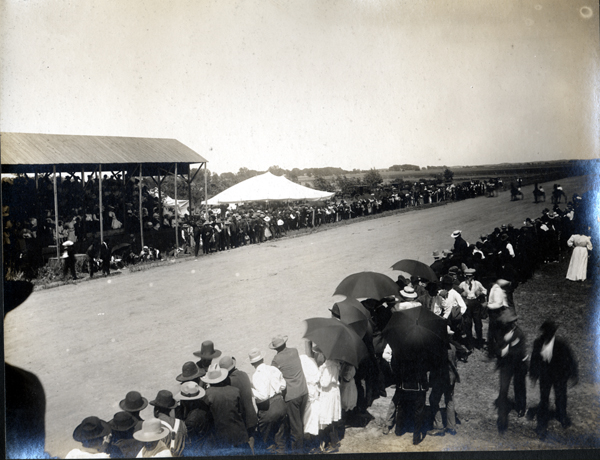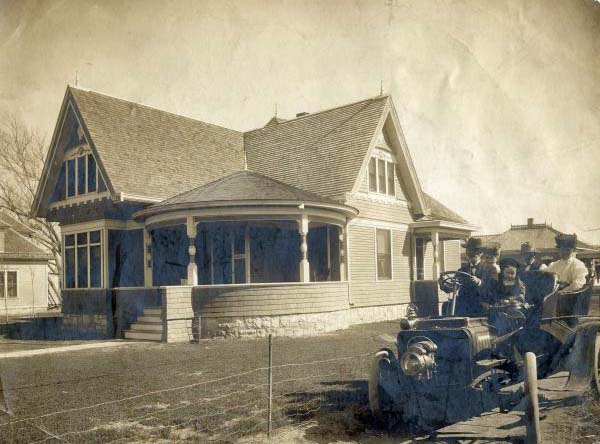This week, I’m forced to take a break from writing about Edwards County Fairs because there were none from 1887 to 1925. But you would be wrong to assume nothing was going on in Kinsley during this time. Another event, the “Old Settlers’ Picnic, took over and would grow to attracting 5000 people.
The “Old Settlers’ Picnic” had a humble beginning on July 8, 1896. Twenty years after Kinsley was settled, the old settlers were beginning to age, and they felt it was time for a reunion. “About forty were present and had a very pleasant time in renewing old acquaintances and exchanging experiences of the early days before the buffalo and the Indian had been replaced by real estate agents and populists.” (Mercury, July 9, 1896)
Besides reminiscing, they enjoyed a campfire and singing. At the culmination of that gathering, F. W. Blanchard was elected president of the group with the intent of holding an “Old Settlers Picnic” every year. You may remember from an earlier article that Blanchard came to the area in 1873.
These picnics, held in South Park, always included talks by early settlers on the history of the area and their experiences. They were always held in June except in 1900 when they tried October and the weather was bad. In 1898 a large tent was purchased to give protection from sun, wind, and rain.
Horse racing and baseball were permanent popular events throughout the years. Other entertainments were added and changed over time. In 1898 there were pigeon shoots which latter gave way to trap shooting. In 1899 foot races, jumping, hammer throwing, hurdles, and high jumping were events.
In 1901 the Prattsburg Woodsmen of the World joined in for a chopping contest and a tug of war. “Dave Heath won the chopping contest in 25 seconds and some of the boys were mean enough to say he picked the logs and knew the punky one. His wife hit him the hardest by remarking that she would not chop any more as she had discovered his ability in that line.”
The editor also commented on the tug of war, “Both teams were made up of a splendid lot of men, but the boys from the country showed that hard work in the field better fits man for a severe physical strain than sitting down hard on chairs in town, and that weight is not the only desideratum in a contest of this kind.” (June 14, 1901 Graphic)
1901 saw bicycle races and ladies unhitching contests added. By 1902, 2000 people attended and the stores closed for the event, including the taverns as “The proprietors had been notified that it would not be a healthy day to do business.”
Alcohol was always discouraged. The June 16, 1905 Graphic reported that “One hobo-looking chap came to the grounds with a big bottle of whiskey sticking out of his pocket. The sheriff pulled it and used it to drive a stake. It was poor glass and broke. It was funny to watch the crowd who saw the performance. Twenty young fellows carefully placed a hand over some convenient pocket and walked swiftly away as though some one was waiting for them in the tall timber.
A dancing pavilion was added in 1903 and a grandstand constructed in 1904. That year also saw a pretty baby contest, the first automobile race, a circus and bronco busting.

Articles over the years revealed that these picnics could be a little dangerous. There were no barriers or fences to protect spectators from events. One time, if a bronc rider had not pulled up and laid himself and the horse down, they would have run over a girl. Another spectator was hit with a ball when walking behind the catcher. Buggies turned over, spectators were kicked and Ed Fletcher was badly cut when a bottle of pop exploded.
In 1905, the Old Settlers’ Picnic became a two-day event. Around 5000 people attended that year and this number would hold into the future. People came to see the auto race as “Many had never seen the big machines before.”
In June 1906, Dr. Pearson and Miley Hawkins competed in the 2-mile auto race. “While on the second turn Hawkin’s trouble began. Man and machine had not been acquainted long enough to become familiar with each other’s eccentricities and instead of making the turn gracefully, the machine went on an exploring trip through the adjoining fields.”

In 1914, C.V. Cessna provided an exhibition of his monoplane, but I’m going to save that story for future article.
Beside the annual trotting and distance horse racing, I found a reference to a “potato race” in 1921. This race required riders with long lances to spear potatoes scattered on the ground. The rider who gathered the most potatoes, won. Hugh Miller, Will Lancaster, James Ely, and Herbert Crawford competed, and it “was the most interesting and amusing event in this part of the program. Lancaster and Miller tied for first place.”
Old Settlers’ Picnics continued until about 1960, long after all the old settlers had been laid beneath the prairie they had tamed. The next county fair would be held in 1925 in Trousdale and that’s where I’ll begin next week. Meanwhile, good luck to the 4-H kids at this year’s virtual fair.
Horse racing grandstand built in South Park in 1904.
